|
||||||||||||||||||||||
![Home - Air Power Australia Website [Click for more ...]](APA/APA-Title-NOTAM.png) |
||||||||||||||||||||||
![Sukhoi PAK-FA and Flanker Index Page [Click for more ...]](APA/flanker.png) |
![F-35 Joint Strike Fighter Index Page [Click for more ...]](APA/jsf.png) |
![Weapons Technology Index Page [Click for more ...]](APA/weps.png) |
![News and Media Related Material Index Page [Click for more ...]](APA/media.png) |
|||||||||||||||||||
![Surface to Air Missile Systems / Integrated Air Defence Systems Index Page [Click for more ...]](APA/sams-iads.png) |
![Ballistic Missiles and Missile Defence Page [Click for more ...]](APA/msls-bmd.png) |
![Air Power and National Military Strategy Index Page [Click for more ...]](APA/strategy.png) |
![Military Aviation Historical Topics Index Page [Click for more ...]](APA/history.png)
|
![Intelligence, Surveillance and Reconnaissance and Network Centric Warfare Index Page [Click for more ...]](APA/isr-ncw.png) |
![Information Warfare / Operations and Electronic Warfare Index Page [Click for more ...]](APA/iw.png) |
![Systems and Basic Technology Index Page [Click for more ...]](APA/technology.png) |
![Related Links Index Page [Click for more ...]](APA/links.png) |
|||||||||||||||
![Homepage of Australia's First Online Journal Covering Air Power Issues (ISSN 1832-2433) [Click for more ...]](APA/apa-analyses.png) |
|
|||||||||||||||||||||
| Last Updated: Mon Jan 27 11:18:09 UTC 2014 | ||||||||||||||||||||||
|
||||||||||||||||||||||
|
||||||||||||||||||||||
![Home - Air Power Australia Website [Click for more ...]](APA/APA-Title-NOTAM.png) |
||||||||||||||||||||||
![Sukhoi PAK-FA and Flanker Index Page [Click for more ...]](APA/flanker.png) |
![F-35 Joint Strike Fighter Index Page [Click for more ...]](APA/jsf.png) |
![Weapons Technology Index Page [Click for more ...]](APA/weps.png) |
![News and Media Related Material Index Page [Click for more ...]](APA/media.png) |
|||||||||||||||||||
![Surface to Air Missile Systems / Integrated Air Defence Systems Index Page [Click for more ...]](APA/sams-iads.png) |
![Ballistic Missiles and Missile Defence Page [Click for more ...]](APA/msls-bmd.png) |
![Air Power and National Military Strategy Index Page [Click for more ...]](APA/strategy.png) |
![Military Aviation Historical Topics Index Page [Click for more ...]](APA/history.png)
|
![Intelligence, Surveillance and Reconnaissance and Network Centric Warfare Index Page [Click for more ...]](APA/isr-ncw.png) |
![Information Warfare / Operations and Electronic Warfare Index Page [Click for more ...]](APA/iw.png) |
![Systems and Basic Technology Index Page [Click for more ...]](APA/technology.png) |
![Related Links Index Page [Click for more ...]](APA/links.png) |
|||||||||||||||
![Homepage of Australia's First Online Journal Covering Air Power Issues (ISSN 1832-2433) [Click for more ...]](APA/apa-analyses.png) |
|
|||||||||||||||||||||
| Last Updated: Mon Jan 27 11:18:09 UTC 2014 | ||||||||||||||||||||||
|
||||||||||||||||||||||
China’s Anti-Ballistic Missile Test: Much Ado About Nothing |
||||||||
|
Air Power
Australia - Australia's Independent Defence Think Tank
|
||||||||
| Air Power Australia NOTAM 14th January, 2010 |
||||||||
|
||||||||
|
||||||||

Second Artillery DF-21C terminally guided IRBM carried by
high mobility WS-2400 TEL.
|
||||||||
|
When William Shakespeare wrote
his comedy ‘Much Ado About
Nothing’, he could have been writing about the media’s reaction to
China’s announcement that they had successfully intercepted a ballistic
missile in mid-course flight.
The technology has been well with China’s grasp for many years, and given the time it takes to organise a test, this means it was either planned in advance to coincide with the Taiwan arms sales or the pieces were in place if Beijing wanted to show its displeasure at the United States or India. Like the January 2007 anti-satellite (ASAT) test, the Chinese appear to have created another grand-strategic blunder. Far from hindering US efforts at supplying Patriot PAC-3 missiles to Taiwan, it strengthens the case; as it strengthens the case for modernizing US nuclear warheads, while also furthering the cause of US ballistic missile defence proponents as well. The reaction of the media and many US observers reflects closely what the US Defense Science Board described as a ‘known surprise’ in their recent report on Capability Surprise, and to professionals in the China analysis community, is yet another expected step along an entirely predictable path.1 Russian Technological Assistance The latest Surface–to-Air Missile (SAM) systems deployed by China have successfully intercepted short range ballistic missiles, using in-service Russian components, and Russian technical assistance. Assisted by Russian technicians, late last year in Xinjiang, the People’s Liberation Army successfully intercepted an SRBM during operational testing of one of its Almaz-Antey supplied S-300PMU-2 / SA-20B Gargoyle SAM systems.2 Of the SAM systems operated by China, the S-300PMU-2 has the best chance of intercepting a SRBM missile as it employs the 48N6E2 missile, which has a warhead optimised for destroying ballistic missiles, and numerous necessary radar design optimisations. All Chinese land based S-300P series SAM systems use variants of the 64N6E Big Bird rotating phased array battle management radar, which can acquire and track ballistic missiles. When employed in its ballistic missile defense (BMD) modes, the radar antenna rotation is stopped, the antenna is mechanically tilted upward, and the radar employs electronic steering of the antenna beam within a fixed angular sector. Chinese SAM sites also employ the 36D6/ST-68U Tin Shield series, and more recently, also the new aelf-propelled 96L6E air defence and early warning radar, which supplement the more powerful 64N6, ensuring aerial target coverage is not lost when the 64N6 is operating in BMD mode. Terminal guidance of S-300PMU2 missiles against ballistic targets is by Track-Via-Missile (TVM), utilising the 30N6E2 X-band space feed phased array illumination and guidance radar. This design is conceptually similar to the AN/MPQ-53 phased array radar used by the United States MIM-104 Patriot SAM system, but superior in key antenna design features.3 |
||||||||
|
S-300PMU2
Favorit / SA-20B Gargoyle ABM Components
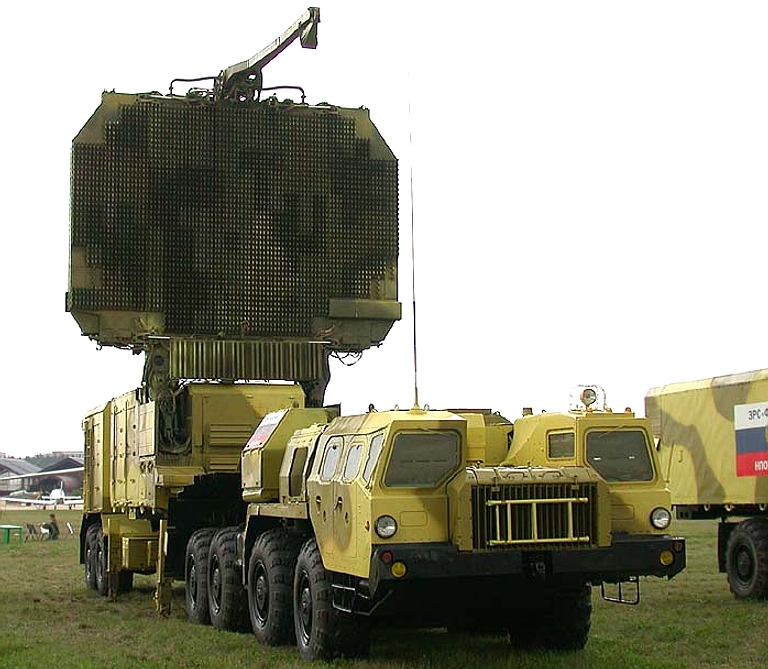 The large self-propelled NIIIP 64N6E2 Big
Bird battle management radar is a space fed transmissive phased array.
In ABM acquisition mode, the antenna is mechanically pointed in the
direction of the incoming ballistic missile, mechanically tilted back,
and the S-band pencil beam is electronically steered through the search
volume (© 2009 Said Aminov, Vestnik-PVO).
 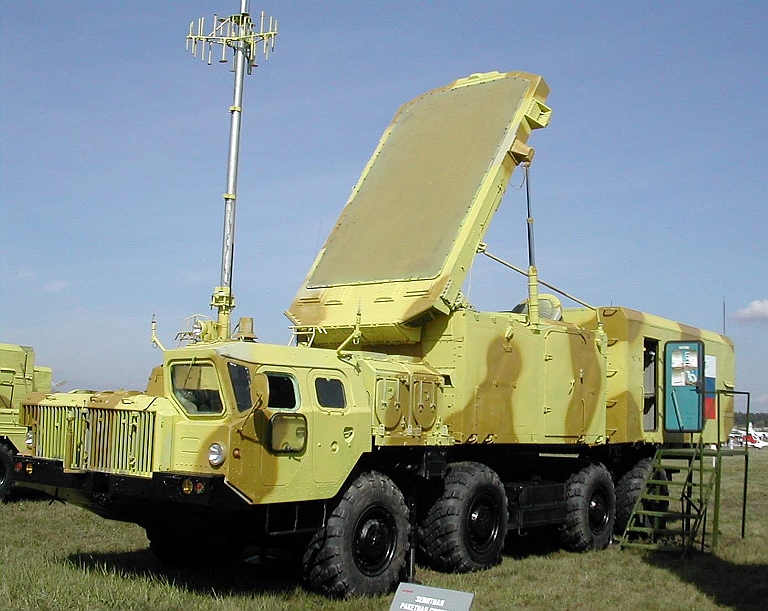 The Fakel
48N6E2 Gargoyle SAM/ABM is guided by the Almaz-Antey 30N6E2 Tomb Stone
phased array monopulse engagement radar, using a Track Via Missile
scheme (© 2009 Said Aminov,
Vestnik-PVO).
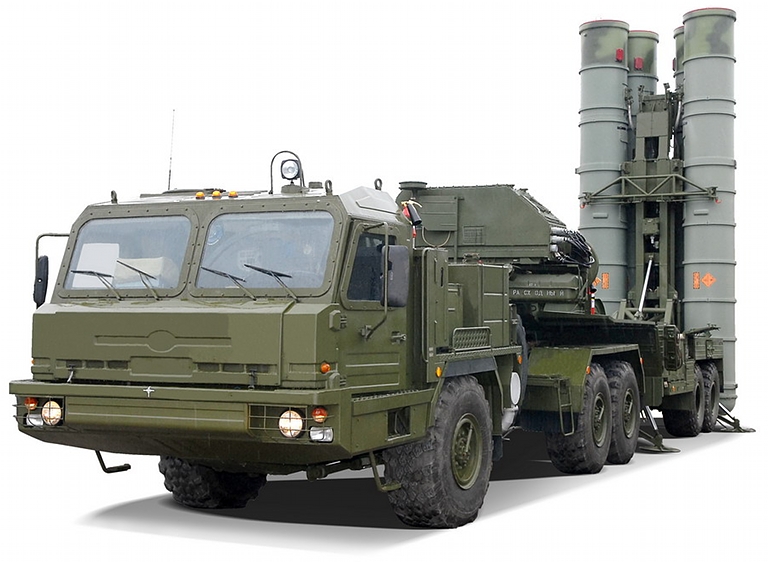 Full rate production S-300PMU2 Favorit systems recently exported to the PLA have been photographed using late model 5P85TE2 TELs with BAZ-6402 series tractors, rather than the earlier towed TEL variant. 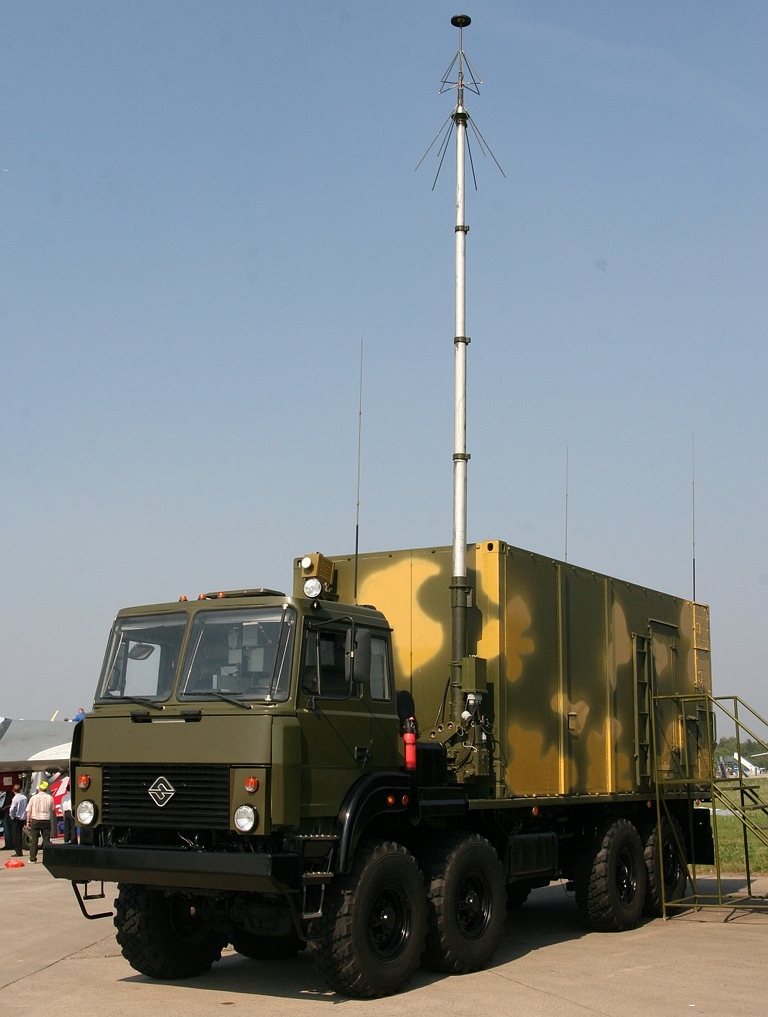 An S-400 55K6 self-propelled Command Post
with
deployed antenna mast, carried
by
an
8
x 8 Ural 532361. Full rate production S-300PMU2 Favorit 54K6E2 CPs are based on the 55K6E CP
design (image © Miroslav
Gyűrösi).
|
||||||||
|
China’s Ballistic Missile and Anti-Satellite Sensors A Chinese ballistic missile
defence system will be linked
to the Second Artillery Corps' numerous ASAT sensor sites, providing
tracking and targeting data for engagement of satellites and incoming
warheads. There are
eight
satellite ground tracking stations, along with the space and satellite
launch facilities at Taiyuan, Wuzhai and Jinquan, supplemented by four
maritime tracking and control ships and two external ground stations in
Kiribati and Namibia.4 To this must be
included the PLA’s early warning and tracking radars which form part of
the HQ-9 and S-300P series SAM systems.
Intercepting an incoming warhead in a test is not an unusually difficult achievement if you have missiles capable of entering the upper atmosphere and good tracking radars. The Nike-Zeus system intercepted 10 out of 14 warheads in 1962, although this was with nuclear warheads.5 The first successful non-nuclear intercept of a dummy Minuteman ICBM warhead in flight was on 10 June 1984 by an infra-red guided Kinetic Kill Vehicle (KKV), which unfurled a 4.2 metre metal net containing 36 spines.6 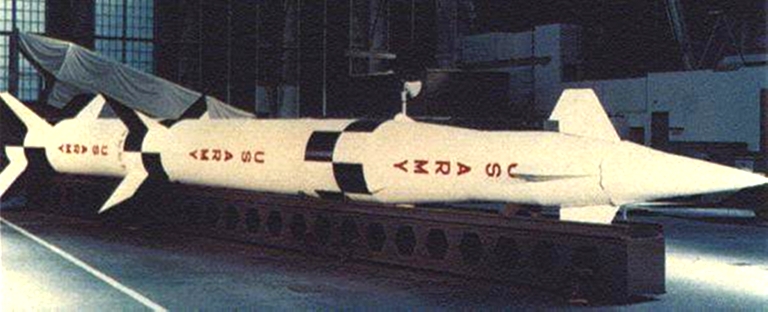 The intended production LIM-49A Spartan exoatmospheric ABM was a direct evolution of the Nike-Zeus ABM demonstrator (US Army). China’s Ballistic Missile and Anti-Satellite Hard Kill Systems The Chinese anti-satellite
system was described by the
Director of the United States Defense Intelligence Agency as a SE-19
KKV launched by a modified road mobile DF-21, or its civilian
derivative the KT-1, from a Chinese manufactured WS-2400
Transporter-Erector-Launcher (TEL).
Being
road mobile means the launcher, along with communications and
maintenance vehicles, could be deployed on the best axis to intercept a
satellite, and making the ASAT system virtually impossible to target
before launch. PLA
forces deployed in another country could bring along an ASAT as part of
their corps level assets to destroy foreign reconnaissance satellites
looking at their forces, even if these forces were deployed well
outside Chinese territory.
The anti-ballistic missile was most likely to have also been launched using a DF-21/KT-1 booster, although a mature system would benefit from a higher velocity launch vehicle, given that in real life incoming warheads will be detected in far less time than during a test range trial. Conclusion The announcement that the PLA
intercepted a missile in
the midcourse phase of its flight was not unexpected, given its ability
to intercept a satellite in space.
This
does not mean that China has a workable operational ABM system, but all
the pieces are now in place if it chose to develop such a system to
protect itself from an Indian intermediate range ballistic missile. The
intriguing question is why the Politburo continues to reveal China’s
new strategic capabilities, reducing the powerful weapon of surprise
whilst strengthening the position of the hawks in Washington, New Delhi
and Taipei. It also
warns India of the strategic need to include decoys and employ other
measures to reduce vulnerability of its missiles.
|
||||||||
| Notes 1. Refer
‘Report of the Defense Science
Board 2008 Summer Study on Capability Surprise, Volume I: Main Report’,
September 2009, Office of the Under Secretary of Defense For
Acquisition, Technology, and Logistics, Washington, D.C., http://www.acq.osd.mil/dsb/reports.htm;
for a discussion of other recent instances of such capability
surprises, please refer May-June 2009 APA Briefs at: http://www.ausairpower.net/APA-Briefings.html
and NOTAMs http://www.ausairpower.net/APA-NOTAM-111109-1.html
and http://www.ausairpower.net/APA-NOTAM-061209-1.html.
2. Mikhail Timofeyev. "Favorit": shooting in the Celestial’, http://www.vko.ru/DesktopModules/ Articles/ArticlesView.aspx?tabID=320&ItemID=280&mid=2891&wversion=Staging, accessed 13 January 2010. 3. Performance figures for the S-300 series are from taken from ‘S300VM (Antey-2500)’, S-300PMU-1 Air Defence Systems and Favorit Long Range Air Defence System’ in ‘Air Defence Systems’, Rosobornexport Catalogue, Rosonboronexport, Moscow, 2003, pp, 10-13. 4. ‘China’s Space Facilities’, Global Security.Org, http://globalsecurity.org/space/world/china/facility.htm accessed 21 February 2009. 5. Papp, D.S. ‘From Project Thumper to SDI: The Role of Ballistic Missile Defense in US Security Policy’, Airpower Journal, Volume One, Number Three, pp. 35 - 51. 6. Payne, K.P. Strategic Defense “Star Wars” in Perspective, Hamilton Press, Lanham, 1986. |
||||||||
|
Air Power Australia Website - http://www.ausairpower.net/ Air Power Australia Research and Analysis - http://www.ausairpower.net/research.html |
||||||||
 |
||||||||
| |
||||||||
|
|||||||||||||
![Sukhoi PAK-FA and Flanker Index Page [Click for more ...]](APA/flanker.png) |
![F-35 Joint Strike Fighter Index Page [Click for more ...]](APA/jsf.png) |
![Weapons Technology Index Page [Click for more ...]](APA/weps.png) |
![News and Media Related Material Index Page [Click for more ...]](APA/media.png) |
||||||||||
![Surface to Air Missile Systems / Integrated Air Defence Systems Index Page [Click for more ...]](APA/sams-iads.png) |
![Ballistic Missiles and Missile Defence Page [Click for more ...]](APA/msls-bmd.png) |
![Air Power and National Military Strategy Index Page [Click for more ...]](APA/strategy.png) |
![Military Aviation Historical Topics Index Page [Click for more ...]](APA/history.png)
|
![Information Warfare / Operations and Electronic Warfare Index Page [Click for more ...]](APA/iw.png) |
![Systems and Basic Technology Index Page [Click for more ...]](APA/technology.png) |
![Related Links Index Page [Click for more ...]](APA/links.png) |
|||||||
![Homepage of Australia's First Online Journal Covering Air Power Issues (ISSN 1832-2433) [Click for more ...]](APA/apa-analyses.png) |
|||||||||||||
| Artwork, graphic design, layout and text © 2004 - 2014 Carlo Kopp; Text © 2004 - 2014 Peter Goon; All rights reserved. Recommended browsers. Contact webmaster. Site navigation hints. Current hot topics. | |||||||||||||
|
Site Update
Status:
$Revision: 1.753 $
Site History: Notices
and
Updates / NLA Pandora Archive
|
|||||||||||||
|
|
Tweet | Follow @APA_Updates | |||||||||||
|
|
|||||||||||||
|
|
|||||||||||||